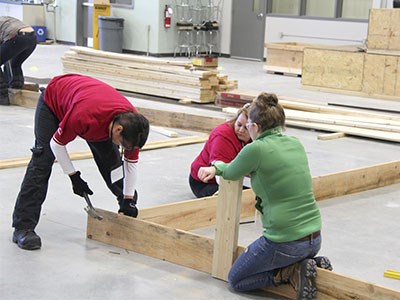Laura Swanson, a student at Cambrian College's new level one pre-apprenticeship women in carpentry program, said she probably would not have enrolled to the program if it had been open to men as well.
“Personally, I probably wouldn't have applied if it was a mixed class because I figured the men would probably have a better foot in the door than I would,” Swanson said.
Swanson always had an interest in carpentry, but it took an all-female learning environment, and full tuition support – from the Ministry of Training, Colleges and Universities – for her to pursue that interest.
Swanson is one of 16 women enrolled in the 37-week program in Sudbury, which provides the basic foundation for a career in carpentry.
The pre-apprenticeship program includes classroom and hands-on learning, and incorporates a two-month work placement to connect the students with employers and gain valuable work experience.
Swanson, and several of her classmates, were at Collège Boréal, March 5, for the Women in Trades Forum, an event that welcomed 200 participants to learn more about the skilled trades and the opportunities they can offer women.
Denis Brouillette, Collège Boréal's manager of trades and apprenticeships, said Swanson's initial apprehension to enter a skilled trades program is not uncommon.
Women represent less than 10 per cent of Collège Boréal's student body enrolled in skilled trades programs.
In the workplace the numbers are even lower. According to a Skills Canada report in 2011, women represented less than three per cent of trades jobs in Canada that year.
Brouillette said some employers have been open to hiring women for skilled trades positions, while others have been less willing to accommodate women. Some workplaces, he said, do not have facilities, such as women's change rooms, that would be necessary to support a female workforce.
Like Cambrian, Collège Boréal has also offered pre-apprenticeship programs for women only, and Brouillette said they have proven to create a more comfortable and encouraging learning environment for the students.
Dominique Brunet, one of Swanson's classmates at Cambrian College, said she signed up for the carpentry program to be more independent.
“I would love to be able to do pretty much everything so that I don't have to depend on a guy,” Brunet said. “It's good for women to know these things.”
Tammy Evans, president of the Canadian Association of Women in Construction, told forum attendees during her keynote address that employers will need to expand their reach to fill the coming labour gap when baby boomers retire.
Evans said around 40 per cent of skilled trade workers in Canada are over the age of 50 and are nearing retirement.
Those retirements, along with changing market demands, will lead to 500,000 skilled trades job openings by 2020, she said.
“We have serious issues if we are not equipping 50 per cent of our workforce with the skills for where our jobs lie,” said Jane Wilson, director of women’s services with Microskills Development Centre, and a founding member of the Women in Trades Network. “If women are not employable, then we as a society are still covering the costs of maintaining individuals who are not employable.”
To encourage women to at least consider the skilled trades, the forum allowed attendees to try out skilled trades under the supervision of bilingual Collège Boréal instructors.
Welding instructor Albert Ménard said he often prefers female students because they are more serious and attentive in class.
A small group of women donned welding helmets and followed Ménard's careful instructions as they took turns trying a welding torch.
One student said she was afraid to use the torch kit on her own, but that uneasiness appeared to evaporate when her turn arrived.




